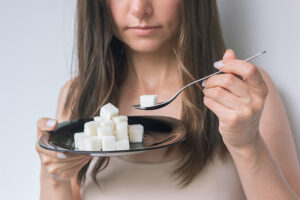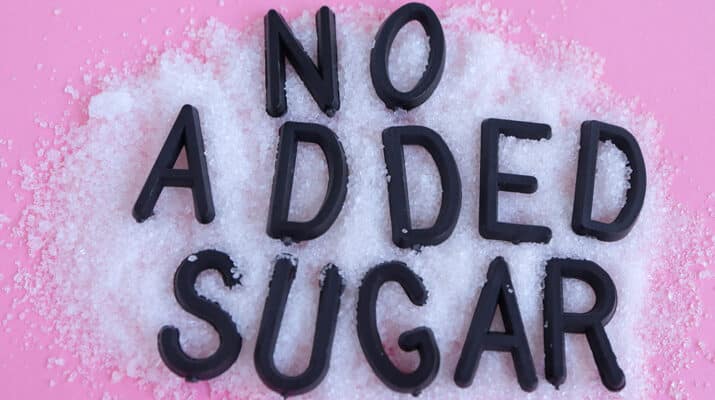You’re probably eating more sugar than you’re aware
By Deborah Jeanne Sergeant
Excess added sugar in the diet increases overall caloric intake quickly, as the calories are very concentrated. Foods high in added sugar often provide little nutritional benefit. They cause the blood sugar to spike and then crash, resulting in overeating later.
According to the American Heart Association, American adults eat about 17 teaspoons of added sugar daily, more than two times the recommended daily allowance. Over a year, that is about 60 pounds of added sugar. How?
Of course, foods like candy, treats and soda are obvious sources of added sugar. But “hidden” sugar sometimes lurks where you would not anticipate.
“It adds up very quickly. It’s important to have sugar and carbs but be aware of what you’re having,” said Philip Smith registered dietitian with Aramark, a food service provider that work with local hospitals.
The “daily allowance” isn’t a requirement. Ideally, a diet should have no added sugar. Some foods contain naturally occurring sugar. However, look for “added sugar” on the label.
When buying canned fruit, look for fruit packed in water or fruit juice, not syrup which is made of sugar.
Unsweetened applesauce is also a better choice. Add plain ground cinnamon (not cinnamon and sugar) to enhance its flavor. Buy dried fruit from the baking aisle, where it’s usually sold without a dusting of sugar, unlike the snack aisle.
“People associate juice with fruit, but you need to portion size it,” Smith said.
Look for 100% fruit juice, not juice cocktail or juice drinks. Some labels are tricky as they boast 100% vitamin C — not 100% juice — and are brimming with sugar.
Examine beverages like fancy coffee drinks, boba tea and smoothies. Unless you make them yourself at home, most of these are liquid desserts. Learn how to create your own and to order flavorful drinks without so much sugar.
Many people look at foods such as yogurt as wearing healthfulness halos. However, nearly all of these are chock full of sugar.
“You can limit the portion size you’re having,” Smith said. “Stick with a portion size in a pre-portioned cup or measure it yourself. Try Greek yogurt; it’s typically lower in sugar. The lowest amount of sugar is from a non-fat, plain Greek yogurt. It’s tart, tangy and sour, which isn’t everyone’s taste. You can flavor it with protein powder.”
Or add a little pure vanilla extract and berries for added flavor and sweetness.
Most protein bars, granola bars, fruit snacks, sweetened dried fruit and fruit and cereal bars have as much sugar as dessert as well. Check the labels for low-sugar varieties.
Energy drinks and sports drinks seem like an easy way to get a boost during the day, but Smith said that many kinds serve up plenty of excess sugar. Choose a zero-sugar variety or hydrate with sparkling water, flavored ice water (just a few lemon wedges to a pitcher) or plain old water.
Non-dairy milk alternatives seem healthful. However, Smith said that these are often high in sugar.
In addition, “things touted as low-fat and fat-free tend to have a lot of sugar to compensate for the lack of fat in the food,” Smith said. “Keep an eye out for that.”
Breakfast cereal can provide a convenient, whole grain breakfast option, but look for no- and low-sugar options. Nearly all “children’s” cereals are loaded with sugar.
Although condiments don’t comprise a large part of most people’s diets, many things like ketchup and barbecue sauce contain a lot of sugar. Since it all adds up, switching to low-sugar varieties can help reduce intake.
Randy Sabourin, owner of Metro Fitness in Syracuse, pays close attention to food labels. However, recently, he noticed the sugar content of breath mints when he purchased some.
“I was surprised at the sugar content,” Sabourin said.
He’s particularly wary of prepackaged foods, as they “aren’t like what your grandparents ate,” he said. “It was right out of the garden or from the farm. Now there’s a level of processing and sugar is one of those things. Read labels and understand them.”
Manufacturers of processed foods tend to rely upon sugar as a crutch to boost flavor and make food seem more satisfying.
“I tell people to eat local, in-season, cook at home and stay away from the center aisles of the grocery store and whatever you’re taking in be careful if it has more than five to 10 ingredients,” said physician Wendy Scinta, medical director of Medical Weight Loss of New York and founder at BOUNCE Pediatric Obesity Program. “We need to simplify our diets. If we rely too much on processed foods, we’ll get hidden sugars in it.”
Why Excess Sugar is Bad
Excess added sugar in the diet increases overall caloric intake quickly, as the calories are very concentrated. Foods high in added sugar often provide little nutritional benefit. They cause the blood sugar to spike and then crash, resulting in overeating later.
Top Sources of Sugar
According to the American Heart Association, these are the major sources of added sugar:
Sugar-sweetened beverages – 24 %
Desserts and sweet snacks – 19%
Soft drinks – 16%
Coffee/tea – 11%
Candy – 9%
Sandwiches – 7%
Breakfast cereals and bars – 7%
Cookies and brownies – 6%
Fruit drinks – 5%
Ice cream and frozen dairy
desserts – 5%
 Finding Sugar By a Different Name
Finding Sugar By a Different Name
Sugar goes by numerous other names in ingredient lists, including:
• Cane juice
• Cane juice crystals
• Cane sugar
• Cane syrup
• Caramel
• Carob syrup
• Corn glucose syrup
• Corn syrup
• Corn syrup solids
• Date syrup
• Dextrose
• Drimol
• Ethyl maltol
• Evaporated cane juice
• Flo malt
• Florida crystals
• Fructose
• Fruit juice concentrate
• Glucose
• Glucose solids
• Golden syrup
• Grape sugar
• High fructose corn syrup
• Isoglucose
• Isomaltulose
• Kona-ame
• Malt syrup
• Maltodextrin
• Maltose
• Molasses
• Nulomoline
• Refiner’s syrup
• Rice syrup
• Sorghum syrup
• Starch sweetener
• Sucanat
• Sucrovert
• Sugar beet
• Treacle or treacle sugar

